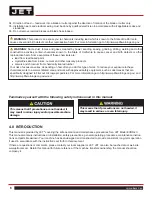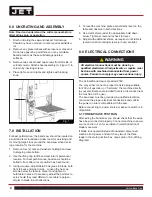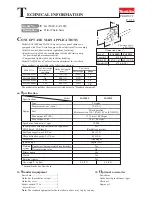
17
EVBS-20
very light feed rate.
3.
When the saw has completed about 1/3 of the cut,
increase the feed rate slightly and allow the saw to
complete the cut.
4.
Keep the feed rate at the same setting and begin a
second cut on the same or similar workpiece.
5.
When the saw has completed about 1/3 of the cut,
increase the feed rate while watching the chip forma-
tion until cutting is at its most effi cient rate (refer to
“
Evaluating Cutting Effi ciency
” below). Allow the saw
to complete the cut.
6.
The blade is now considered ready for use.
13.2 SETTING BLADE SPEED
1.
Refer to Speed and Pitch chart in section 16.0. Se-
lect speed setting for the material to be cut.
2.
While machine is NOT running, move gear shift lever
(B, Figure 2) to required speed setting (high or low).
3.
Start saw using the pushbutton.
4.
Turn speed setting knob (C, Figure 2) to
required speed. Turning knob clockwise
increases speed; counterclockwise decreases
speed.
13.3 EVALUATING CUTTING EFFICIENCY
The best way to determine whether a blade is cutting effi -
ciently is to observe the chips formed by the cutting.
•
If chip formation is powdery, then the feed rate is too
light, or blade is dull.
•
If the chips formed are curled, but colored – blue or
straw colored from heat generated during the cut –
then feed rate is excessive.
•
If chips are slightly curled and not colored by heat,
then the blade is suffi ciently sharp and is cutting at
its most effi cient rate.
Bad Grindings
Fig. 18
12.6 SECONDARY ANNEALING
Anneal the weld 2 to 3 times again after grinding.
12.7 WELDER CLEAN-UP
It is important that the welder jaws be kept clean at all
times. The jaws and inserts must be wiped or scraped
clean after every weld. Doing this will ensure better welds
by:
1.
Holding proper alignment.
2. Preventing
fl ash from becoming embedded in the
blade.
3.
Preventing shorts or poor electrical contact.
13.0 BAND SAW OPERATION
Consult section 9.0 for identifi cation of the controls.
Unlock the control panel using the provided key.
13.1 BLADE BREAK-IN PROCEDURE
New blades are very sharp and therefore have a tooth
geometry that is easily damaged if a careful break-in pro-
cedure is not followed. Consult the blade manufacturer’s
literature for break-in of specifi c blades on specifi c mate-
rials. The following procedure will be adequate, however,
for break-in of JET-supplied blades on lower alloy ferrous
materials.
1.
Use a section of round stock.
2.
Operate the saw at low speed. Start the cut with a
!
Never operate band saw without blade and wheel
covers in place and secured.
!
Move gear shift lever only when machine is NOT
running, to prevent damage to gearbox.
!
Rotate speed setting knob only when machine is
running.
Summary of Contents for 891100
Page 34: ...34 Vertical Band Saw 19 0 WIRING DIAGRAM ...
Page 35: ...35 EVBS 20 NOTES ...
Page 36: ...36 Vertical Band Saw NOTES ...
















































